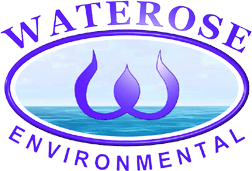 | ||||||
| Articles | Projects | Resume | Cartoons | Windsurfing | Paintings | Album |
Sooke River Twelve Month Baseline Water Quality Study for Salmonids
by Judith R. Burke

Waterose Environmental Services
Vancouver Island, BC

5. Discussion and Recommendations
5.1 General Parameters
The general parameters include flow, air and water temperature, dissolved gases, and pH. The Sooke River maintained flow throughout the year, whereas DeMamiel subsided to zero visible in the summer.
Temperatures remained moderate through the year. Water temperatures were within stress levels for salmonids. The highest peaking 15.3 °C occurred in DeMamiel in the summer season. Cooler temperatures increase the amount of dissolved gas in the water. The mean level of dissolved oxygen was fair but periodically fell below the recommended level of 9 mg/L. The mean dissolved carbon dioxide was slightly elevated, particularly in the summer months for the three sites, exceeding the 20 mg/L threshold. Recall that elevated levels of carbon dioxide decrease pH and increase the potential for ammonia toxicity. The mean pH was slightly acidic and within tolerance levels for salmonids. The dominant soils and biogeomatic classification are characteristically slightly acidic in the lower SRW.
5.2 General Water Quality Parameters
These general parameters include conductivity, turbidity, and hardness. Conductivity can normally range from 50-100 µs/cm in natural streams. The conductivity measurements were reasonable except for specific short events that lasted only several hours. Additional testing was implemented to monitor frequency and duration of these events. Frequent events occurred in DeMamiel and to a lesser degree at Martins. These events correlated to extremely high levels of calcium carbonate as measured by the hardness test, and correlated to high sulphate tests results. While this did not visibly impair the development of the fish, this is noted as something of potential concern that requires additional tests and study. The turbidity was low, with minor peaking occurring in the fall after increasing precipitation. The levels are not a concern for salmonids. Recall that Coho are visual feeders, and excess turbidity can impair the clarity of the water column and can indicate high levels of suspended solids in the water column. This is not a concern in the lower SRW. The total hardness was low, with the exception of specific short-term events as noted in the discussion about conductivity.
5.3 Other Ionic Substances
This section includes the remainder of the parameters of interest, except metals. Nitrogen (Nitrate, Nitrite, Nitrogen Ammonia) and Phosphorus were present in minute quantities; however, the measured results neared the minimum detection limits of the instrument and an alternative method should be considered for more accurate results. Fluoride was consistently present in the system in quantities below levels of concern to fish. Sulphate was not present except during the short-term events at DeMamiel and Martins. It is known that high levels of calcium carbonate interfere with the chemical reaction for the sulphate test, and cause a white precipitate to form. The precipitate interferes with the results of the test; therefore, the test results for sulphate must be recognized as due to interference rather than the actual presence of sulphate. Sulphide was barely detected and neared the detection limits for the test. Bromine and chlorine were consistently detected, but the results were below the minimum detection limit for the instrument. Silica was consistently present in the system but below levels that would be of concern for salmonids. Recall that the rock and soils for this area are silica based, and therefore one would expect downstream deposition of parent materials with a silica signature. The tannin and lignin test results showed minor elevated levels in the fall, which may be attributed to decomposing organics.
5.4 Metals
The group of metals was tested with the colorimeter. While in some cases, the test results approach the minimum EDL of the instrument; there is enough information to claim minute presence of some substances. These are also substances, which are normally found in the parent material of this area. These include aluminum, copper, iron, and, manganese. The other metals tested positive, but below the minimum EDL. These include chromium, molybdenum, nickel, and, zinc. An alternative method should be used to test for metals in this system.
5.5 Recommendation
The lower SRW is valuable habitat for anadromous fish. DeMamiel and Charters are choice streams for Coho, and the Sooke is choice habitat for Chum. The lower SRW should be tested once per mid-season for surface water parameters of concern to fish. In addition, due to periodic events, DeMamiel is an excellent candidate for an automated water quality monitoring station for 1-5 years. The station should be equipped a mechanism to obtain a sample for analysis during an event. It is important to identify the ions that cause the peaking in conductivity and determine if it is more than calcium carbonate. The next step is to methodically test upstream to identify a source. The lower SRW is poised for significant development. It is important to continue with baseline water quality monitoring to measure the long-term impacts of significant development and harvesting on the anadromous salmonids and resident freshwater species.
Next Section 6. References
Return to Table of Contents
For more information about the Sooke River Watershed:
 Email Judith Burke at Waterose Environmental Services
Email Judith Burke at Waterose Environmental Services

Other Water Quality Projects by Waterose:
Water Quality Tests Offered by Waterose
Twelve Month Baseline Water Quality Study for Salmonids in the lower Sooke River Watershed (Victoria Times Colonist Enviro News)
Twelve Month Baseline Water Quality Study for Salmonids in the lower Sooke River Watershed (Sooke Mirror)
Water Quality Project on Musqueam Salmon Stream in Urban Vancouver
Analysis of Coliforms and Nutrients in surface waters flowing into Esquimalt Lagoon
Water Quality Monitoring on Ayum Creek, a wild salmon and trout bearing stream, for Society for the Protection of Ayum Creek and Fisheries and Oceans, Canada
Testing the Waters
Story in Sooke News Mirror, March 28, 2001 about the Automated Water Quality Monitoring Project

 email Waterose
email Waterose
Please Sign My Guestbook
Please View My Guestbook

| Articles | Projects | Resume | Cartoons | Windsurfing | Paintings | Album |
 | ||||||